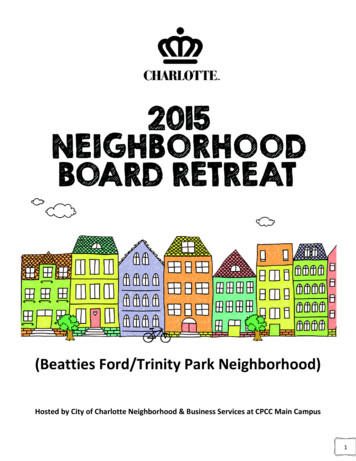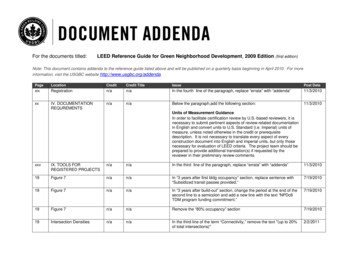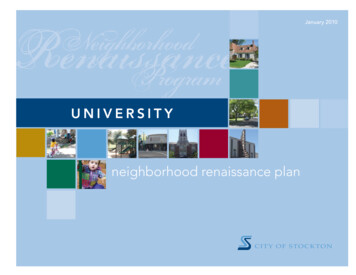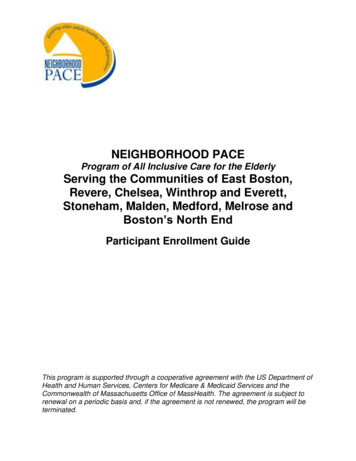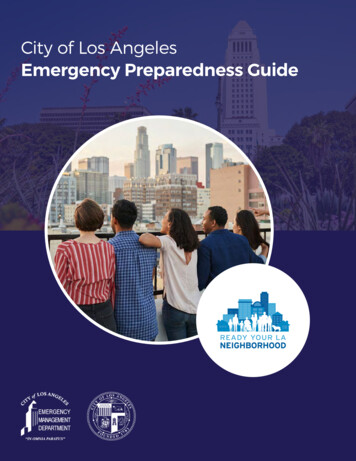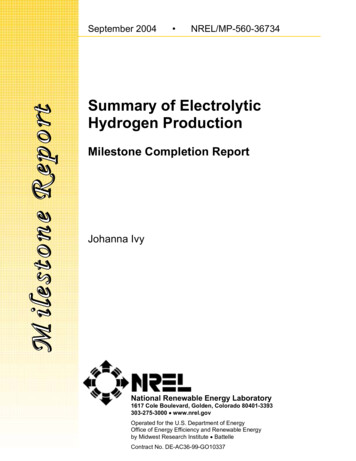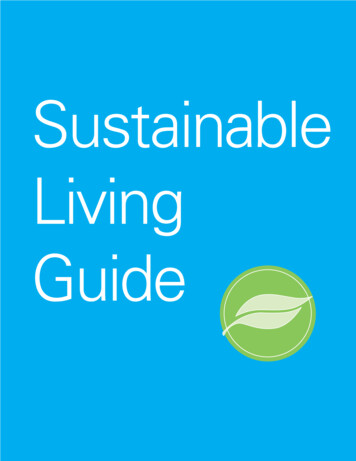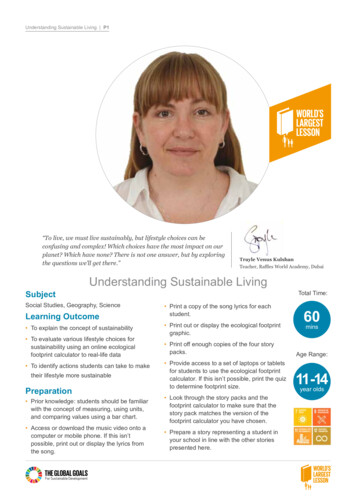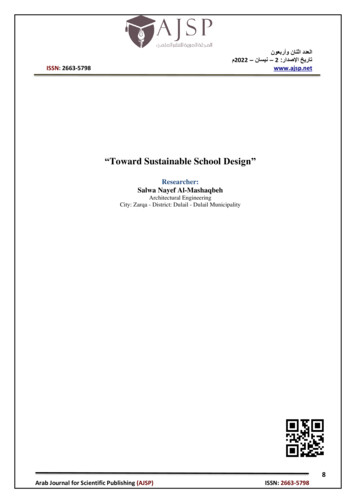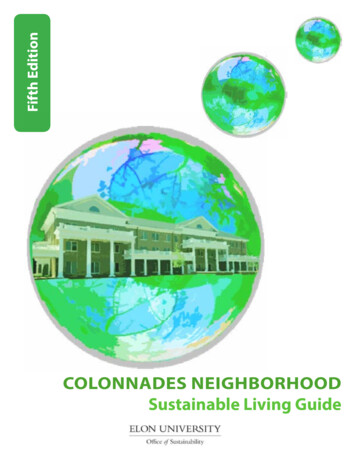
Transcription
Fifth EditionCOLONNADES NEIGHBORHOODSustainable Living Guide
Sustainability is a part of residential life at Elon. The three Colonnades residence halls completedin 2011 are the first residential buildings on campus to be built according to the LEED 2009requirements. More importantly, all Colonnades neighborhood residents can adopt sustainableliving habits to reduce their environmental impact. This guide suggests tips to reduce yourenvironmental impact in terms of power and water consumption, waste management,Table of ContentsColonnades LEED 1Power 2Waste Management 3In The Residence 4Transportation 8Get Involved 9The Office of Sustainability Green Building Education Intern, Molly Schriber, created this guideduring the 2010-2011 academic school year, and it was updated in summer 2015.
Colonnades LEED Elon’s Green Building Policy (2009) specifies new buildings exceeding 8,000 square feetwill pursue LEED certification. The three residence halls in the Colonnades Neighborhoodcompleted in 2011 are each about 33,500 square feet and are LEED Gold certified. Thisdemonstrates Elon’s commitment to sustainable design and construction practices.What is LEED ?Highlights 2011 Residence HallsLEED stands for Leadership in Energy andEnvironmental Design. Increased overall energy efficiency of eachresidence by at least 34%The U.S. Green Building Council createdLEED as a way to mainstream sustainablebuilding and design processes to encapsulateenvironmentally conscious and energy efficientprinciples.The three 2011 residence halls are LEED Goldcertified.The two 2007 residence halls are not LEEDcertified, but they do have sustainable features.The three residence halls in the ColonnadesNeighborhood completed in 2011 followed theLEED 2009 requirements. LEED 2009 is uniquebecause it includes a regional priority category.LEED 2009 Credit Categories Installed a geothermal system to serve as theprimary source of heating and cooling Used high-efficiency lighting and mechanicalsystems Diverted about 90% of construction waste from thelandfill Installed low-flow toilets, shower heads and otherplumbing fixtures Installed vegetation adapted to the local climate Used regional building materials Used products with recycled content Used low-emitting materials containing low or noamounts of Volatile Organic Compounds (VOCs) Adopted a green cleaning program for use in thebuildingsHighlights 2007 Residence Halls Sustainable Sites Water Efficiency Energy & Atmosphere Materials & Resources Indoor Environmental Quality Innovation & DesignProcess Regional PriorityElon University is amember of the U.S.Green Building Council. Installed solar thermal systems to meet hot waterneeds Used high-efficiency lighting and mechanicalsystems Installed low-flow plumbing fixtures Installed vegetation adapted to the local climate Used products with recycled content Used low-emitting materials containing low or noamounts of VOCsLEED is an internationally recognized benchmark for design, construction and operation ofhigh-performance green buildings. (www.usgbc.org)1
POWEROn average, the Colonnadesresidence halls consume17,747kWh per monthduring the school year.This equates to 165,454pounds of CO2 each schoolyear. This is the equivalentemissions of burning over8,200 gallons of gasoline.Help reduce this amountby following the simple tipsprovided here.Energy Saving Tips Switch your light bulbs to CFLs When not in use, turn off lights and appliances,such as televisions, speakers and computers Unplug cell phones, computer chargers andappliances when not in use Keep the windows and exterior doors closed whenthe AC and heat are in use Use a fan whenever possible to cool a room beforeturning down the thermostat Close blinds or curtains on hot days to reduceroom temperature increase Open blinds or curtains on cool/cold days to allowin sunshine to increase the room temperature Use less hot water: wash your clothes in cold waterand take shorter and cooler showers When daylight is sufficient, do not use lightsThermostatsPhantom LoadsKeep your thermostat on 76o or higher on “cool”during warm months and 68o or lower on “heat”during cold months. Make small adjustments tothermostat at first. Adjusting the thermostat tothe season can cut energy consumption by 4% perdegree.Items that are plugged in still use energy evenwhen they are powered off. The energy that is stillbeing used while an appliance or charging cord ispowered off but still plugged into the outlet is calleda phantom load.Thermostats vary by building; please see thePhysical Plant’s Web site elon.edu/physicalplant foran educational video on the appropriate settingsfor your thermostat.2009 Average Energy Consumptionof Homes in North CarolinaBenefits of CFLs A compact fluorescent light bulb or “CFL” cansave up to 40 throughout its lifetime. It uses 75% less energy, lasts 10x longer andproduces 75% less heat than an incandescentbulb.2Source: eia.gov Residential Energy SurveyThe average North Carolina household uses 1,098 kWh per month. (www.eia.doe.gov)
WASTE MANAGEMENTWhat is it recycled into?Reduce Bring a coffee travel mug instead of using disposablecups and lids Use a reusable water bottle instead of bottled water Purchase fewer food items with excess plastic orpaper wrappingsPolar fleece, tote bags, furniture, carpetLaundry detergent bottles, oil bottles,pens, recycling containers Only print documents that are necessary to have inhard copy Set printing property settings to print double-sided(duplex) Purchase quality goods that will not go out of style orbreak quicklyReuse Get creative! Make that glass bottle your new water bottle Make a notepad out of your old documents or draftsof papers Save those glass food containers for storing leftovers;do not heat in the microwave or oven Reuse cardboard boxes as designated in roomrecycling containersRecycle Paper (all kinds & colors)Where do you recycle oddities?Cardboard locations: Anywhere there is a paperrecycling bin. Break cardboard down and placeit behind or next to the paper recycling binPrinter Cartridge locations: ColonnadesNeighborhood Office; Moseley Center, near themailroomHousehold Battery locations: Belk Library, mainstairwell; Moseley Center, near the mailroom Magazines Aluminum and Steel/Tin cans Newspaper Batteries Cardboard Printer Cartridges Plastic #1- #7 Small ElectronicsSmall Electronics locations: Belk Library,main stairwell; Mooney, stairwell; McEwenCommunications, room 105Please see the Office of Sustainability’s Web sitefor a complete list: www.elon.edu/sustainability. GlassIn 2013, the average U.S. citizen generated 4.4 pounds of trash per day; 1.5 pounds of that waste wasrecycled or composted. (epa.gov)3
IN THE RESIDENCEBedroom Turn off and unplug items when not in use Use CFLs in light fixtures Keep windows closed if using air conditioning or heat When purchasing new bed linens, consider buying organiccotton or other eco-friendly products such as hemp or bamboo When cleaning out closets consider donating items to localcharities and thrift stores Clean your room to increase indoor environmental qualityleading to improved productivity and happiness Consider buying clothes from local second-hand shops Designate a paper recycling bin or basket for unwanted papersand magazines Use a desk lamp or natural light when possible, instead ofoverhead lightingKitchenGo to epa.gov/epawaste/education/lunch.htm tolearn how to make a waste-free sack lunch. Turn off the water if not in immediate use Buy less paper napkins, use more washablecloth napkins Use cold water when possible as hot waterrequires a large amount of energy Use the dishwasher only with full loads Use an electric tea pot to heat water ratherthan a stove top Unplug kitchen appliances such as a toaster,coffee maker, electric tea pot and otherswhen not in use To decrease temperature fluctuations in therefrigerator allow hot food and container tocool first before moving to the refrigerator Designate a recycling bin to put next to theindoor trashcan Stock up the freezer, less available space inthe freezer uses less electricity to cool Buy a water filter pitcher to fill a reusablewater bottle rather than buying bottled water4For every minute a refrigerator door is open, it will take three minutes for it to regain its temperature.Don’t leave the door open.
Bathroom Report all faucet leaks and faulty toilets to PhysicalPlant by completing a work request via FIXit Take shorter and cooler showers Turn off the shower or faucet water while you shaveand brush your teeth Avoid using the toilet as a waste bin - put feminineproducts and old medications in the trashcan Buy a long lasting shower curtain that does not needto be replaced frequently Unplug hairdryers, electric razors, straighteners andcurling irons when not in use Leave bathroom door open after showering toprevent mold growth Use washcloths to avoid face pad and cotton swabwaste Think about purchasing more environmentallyfriendly toiletries and make-up Keep your bathroom clean to prevent mold growth,illness and to improve quality of lifeComputer TipsLoungeLaptops use 50% less energy than desktops Unplug devices such as TV, DVD player, stereos,Xbox, Playstation and others when not in use Use lamp lighting and natural lighting as much aspossible, rather than overhead lights Purchase electronic devices with the Energy StarlabelTrack your energyWith Building Dashboard, you can monitormost residence hall energy consumption daily,monthly and annually. Compare residences andsee how many pounds of carbon are emitted. Visitbuildingdashboard.net/elon/. Allow your laptop computer to almostcompletely drain its battery before chargingagain Unplug laptop charger when not in use Shut down all computers when you are awayfrom them Remember screen savers do not save anyenergy and actually use more Enable energy saving settings on yourcomputer Research the more energy efficient andenvironmentally aware computer companiesbefore purchasing a new computer. Seeenergystar.gov.According to the USGS, the average U.S. citizen uses 80 to 100 gallons of water per a.html)5
LaundryLABELS TO LOOK FOR Use the washing machine with full loads of clothes When small loads are necessary adjust the water levelaccordinglyHigh Efficiency Detergent Do laundry less often Set the water temperature to Cold/Cold which reducesenergy consumption Use laundry detergent with the high efficiency symbol,when applicable (Front loading washing machinesrequire high efficiency detergent to minimize soapsudsfor the machines.) Also look for phrases such as non-toxic, biodegradable, chlorine-free, non-petroleum basedSierra Club SealEPA: Design for theEnvironment Hang clothes on a drying rack or outside wheneverpossible Clean lint screens from the dryer; a dirty screen can use30% more energyGreen Seal CertifiedConventional washing machines can use 40 gallons ofwater per wash. Energy Star washing machines are 37%more energy efficient and use less water.Green CleaningWhy Use Green Cleaning?Most conventional cleaning products are petroleum based and high in toxic chemicals that cause healthproblems. Green cleaning uses natural products and methods that are effective in the battle on dirt andgerms and do not have adverse side effects. In addition to improving indoor environmental quality, greencleaning practices reduce transmission of toxic chemicals to our outside environment. The EPA states thatindoor air pollutants can be 100 times higher than outdoor pollutants. Breathe easy and stay healthy withgreen cleaning. Look for the labels and seals above to help youdecide which products are best to useNeed to save money? Make your owncleaning products. Purchase cleaning products that feature conceptssuch as biodegradable, non-toxic, chlorinebleach-free, etc. All purpose cleaner: ½ cup of vinegar,½ cup of baking soda and 8 cups ofwater Buy washable cloths rather than using disposablewipe cloths or paper towels Carpet cleaner: Equal parts of vinegarand warm water and 1 tsp. of soap toremove stains and odors Use old t-shirts, boxers and wash cloths ascleaning cloths Toilet Bowl Cleaner: ¼ cup of bakingsoda and ½ cup of vinegarLearn more at ecocycle.org/hazwaste6In 2013, paper and paperboard accounted for 27% of municipal solid waste generated in the U.S. (epa.gov)
PurchasingMake careful and thoughtful consumer choices. Support recycled clothing, buy from local vintage or thriftstores. Don’t be fooled by ambiguous terms on labels and packaging such as 100% natural; it’s not alwaystrue. Try to buy items that will be long-lasting rather than one-time use or go out of style quickly; purchasefor quality. See climatecounts.org for a comprehensive list of the companies that are taking strides to reduceclimate change and their environmental impact.Be thoughtful when creating organization souvenir t-shirtorders. Think about reducing the frequency of t-shirtorders; frequent t-shirt orders have large environmentalimpacts. If orders are necessary, consider local and moresustainable t-shirt options.Energy StarUSDA Certified OrganicFoodFood for ThoughtFair Trade CertifiedForest Stewardship CouncilMade from RecycledMaterialsAnimal-Free TestingEnvironmental Impact of Bags Paper and plastic grocery bags bothhave their consequences, so avoid themall together when possible. Try to buy local in North Carolina but keep in mindthat driving to a distant farmers’ market might befarther and expend more energy than the nearestcoop or grocery store. Combine your trip or carpool with a friend to thefarmers’ market. Go to localharvest.org for nearbymarkets. Look for the organic label but remember that somefarmers choose not to pay the certification fees butare still practicing organic. Don’t be afraid to ask afarmer about his or her practices. Buy Fair Trade whenever possible, it ensures that thefarmers are paid a fair price for their product. Whilemarket prices go up and down, the farmers receivea more consistent price for their product alwayshovering above the average market price. Buy seasonally. This reduces the environmentalfootprint of food grown out of season and theneed for transportation. View a seasonal food chartcompiled by the NC Department of Agriculture atncagr.gov/markets/chart.htm. Be thoughtful when choosing to eat out atrestaurants. Go to eatwellguide.org for ideas ofnearby sustainable restaurants, bakeries and more. Remember to bring a reusable bag withyou or leave a collapsible bag in yourschool bag or purse.Plastic bags can take up to 1,000 years to break down. (worldwatch.org)7
TRANSPORTATIONIn 2014, a survey ofon-campus studentsat Elon indicatedthat 57% of thosesurveyed carpoolwhen they leavecampus. 7% said theybike to get aroundcampus.WalkZimrideEnjoy the fresh air! 89% of on-campus studentssurveyed in 2014 walk while on campus. Walk asyour mode of transportation. This is the perfectopportunity to enjoy Elon’s beautiful gardens.This program provides an Elon-specific onlinenetwork to help users find carpool partners. Theprogram is FREE to students, faculty and staff. Seezimride.com/elon to join.BikeCar ShareCampus Recreation rents bikes to students by thesemester for 25. Elon’s Cycling Club is a greatinformation hub to learn more about purchasingbikes and maintenance.Elon’s Car Sharing program allows members to “rent”a car when they need one for hourly or daily use. Onthe Sustainability Web site, see Campus Initiatives,Transportation to become a member.BioBusLong Distance BusThe Elon BioBus runs on B20 fuel which is 20%biofuel. See org.elon.edu/transit/biobus/ forschedule and route information. The routes servicelocal apartment complexes and various places offcampus.Heading to Atlanta, Charlotte or Savannah? Checkout Greyhound Express Buses which travel to 29cities in the Southeast region alone. Seegreyhound.com for schedules and stations.Train8The Amtrak station is located in downtown Burlington and stops at a number oflocations including Greensboro, Charlotte, Raleigh, Winston-Salem and more. Seeamtrak.com for schedule information.About18.5 million barrels of oil are burned each day in the U.S. Three fourths of this is used fortransportation. (eia.gov)
GET INVOLVEDSustainable Organizations On CampusThese are examples of organizations on campus that have activities related to sustainability.Eco-RepsThis is a peer-education group that promotesawareness of sustainability issues and efforts. EcoReps teach lessons for Elon 101 and other classes andalso work with Residence Life staff on sustainabilitythemed programs.Sierra ClubElon Community GardenThis garden was initiated by an EnvironmentalEthics class and is now maintained by studentsgiving them the opportunity to learn aboutgardening and community food sustainability. Thegarden is located next to the Powell House, behindthe tennis courts.This group is dedicated to sustainable causes andservice in the name of sustainability. Activities includevolunteering at local environmental organizationsand in the Elon Community Garden, clean-ups andenjoying the wild places of the earth.Elon OutdoorsStudents for Peace & JusticeSustainable Living Learning CommunitySfPJ is a student run social activism organization thatstrives to educate and act to create a better world forall.These students live together in a learningcommunity focused on exploring what it means topersonally live a more sustainable lifestyle.EnactusElon’s Habitat for Humanity ChapterEnactus focuses on mobilizing university studentsto make a difference in their communities whiledeveloping the skills to become socially responsiblebusiness leaders.Project PericlesThis office is a branch of Campus Recreation,located in Koury Athletic Center, which organizesoutdoor trips including hiking, white water rafting,rock climbing and ski trips.Habitat for Humanity focuses on homelessness andpoverty housing by pledging to raise funds to buildone house in Alamance County each year.Campus KitchenThis program utilizes un-served food from theMany Periclean Scholars classes focus on sustainability campus dining facilities and donations to make anddeliver meals to those in need in the community.issues and activism.Contact the Kernodle Center for Service Learning & Community Engagement as a resource for servicelearning opportunities with sustainability themes for your organization and personal involvement.Visit elon.edu/servicelearning.Sustainability EducationThe Department of Environmental Studies offers the following degrees:· Environmental Studies (B.A. and B.S.)· Environmental and Ecological Science (B.S.)· Environmental Studies/Environmental Engineering (B.S. with Engineering).There is also an environmental and sustainability studies minor. A number of departments offersustainability and environmentally themed courses. The Center for Environmental Studies encouragesstudents to conduct environmentally focused research, coordinate and participate in community outreach,organize conservation projects and publish their research in Visions Magazine.Elon University established the Elon University Forest in the fall of 2010, dedicating 56 acresas a land and nature preserve.9
5 SUSTAINABLE LIVING TIPS TO MAKE A DIFFERENCE1. Increase your time with friends; commute together to off-campus places of interest.2. Limit the use of disposal cups and plates -- Encourage your friends and guests to “BringYour Own”.3. Encourage green habits at social events -- recycle and consider composting.4. Print wisely and reuse -- reduce text size or print duplex to use as few pages as possible;reuse old syllabi, tests and papers to make grocery lists, notes and more.5. Take the Elon Sustainability Pledge.Elon UniversitySustainability PledgeTake the Sustainability Pledge. Individual action makes a difference!Your pledge can be renewed each semester. Pledge now atelon.edu/sustainability/pledge.Alamance 2132104 Campus BoxElon, NC uElonSustainabilitySustainableElonPrinted on 100% post-consumer recycled paper.
The three 2011 residence halls are LEED Gold certified. The two 2007 residence halls are not LEED certified, but they do have sustainable features. The three residence halls in the Colonnades Neighborhood completed in 2011 followed the LEED 2009 requirements. LEED 2009 is unique because it includes a regional priority category. Colonnades LEED
